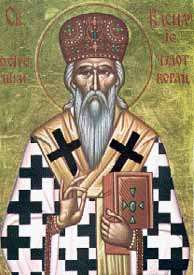Basil of Ostrog
Saint Basil of Ostrog (Serbian: Свети Василије Острошки/Sveti Vasilije Ostroški, pronounced [sʋê:ti ʋǎsiːlije ǒstroʃki], 28 December 1610 – 29 April 1671) was a Serbian Orthodox bishop of Zahumlje who is venerated as a saint in the Eastern Orthodox Church.
Saint Basil of Ostrog | |
|---|---|
 Icon of Saint Basil of Ostrog | |
| Bishop of Zahumlje and Herzegovina | |
| Born | 28 December 1610 Mrkonjići, Sanjak of Herzegovina, Ottoman Empire |
| Died | 29 April 1671 (aged 60) Ostrog Monastery |
| Venerated in | Eastern Orthodox Church |
| Major shrine | Ostrog Monastery |
| Feast | 12 May (O.S. 29 April) |
Life
Early life
Stojan Jovanović (Serbian Cyrillic: Стојан Јовановић) was born on 28 December 1610, in the village of Mrkonjići at the bottom of the Popovo field in the Ljubinje nahija (Herzegovina), at the time part of the Ottoman Empire. His father was Petar Stojanović and his mother was Ana. He was a diligent and obedient child, and he inherited his graciousness and benevolence from his parents. Having raised cattle on the Herzegovinian hills and mountain slopes, he shared all of his food with poorer people. The Ottomans started to notice him, unenthusiastically monitoring this gifted young man. His parents, in order to avoid any danger, took him to the nearby Zavala Monastery, where his paternal uncle, the hieromonk Serafim served as the hegumen of the monastery. There he would study, and be protected.[1]
Studies
Having a rich library at his hands, the young Vasilije especially liked the cells dug into the rocks above the monastery church of the Presentation of the Blessed Virgin Mary. His character quickly made him a master of the Bible and basic Christian mysteries. After a while his uncle sent his protégé to the Monastery of the Most Holy Mother of God, the Tvrdoš Monastery in Trebinje, for further spiritual and theological studies.[1]
Bishop of Zahumlje
St. Basil's modesty made him reluctant to occupy high positions. However, his piety, humility and dedication to the Church made him well suited for the role and he was elected as Bishop of Zahumlje and Skenderija, which he reluctantly accepted in 1639. He retired from the position ten years later in 1649.
Legacy
After his death in 1671 he was buried at the Ostrog Monastery he had founded in Montenegro, and his tomb in a cave-church soon became a site of pilgrimage for Christians (both Orthodox and Roman Catholic) and Muslims drawn by reports of miracles occurring through the intercession of the saint. The Monastery of Ostrog is now one of the major pilgrimage sites in the Balkans, and large numbers of pilgrims gather particularly at Pentecost. St. Basil of Ostrog is commemorated in the Serbian orthodox liturgical calendar on April 29 (May 12 in the Gregorian Calendar).
The Orthodox seminary in East Sarajevo (Pravoslavni bogoslovski fakultet Sveti Vasilije Ostroški), part of the University of East Sarajevo, is named after him. A church in Nalježići, in the Grbalj region is named after him.
See also
References
- Slobodan Mileusnić (2000). Sveti Srbi. Prometej. p. 149.
Љубинској нахији (Херцеговина), при дну Попова поља, у селу Мркоњићи, рођен је 28. децембра 1610. године од мајке Ане и оца Петра син Стојан, будући светитељ Василије. Као дете посебно га је красила марљивост и послушност. Од родитеља је наследио милостивост и добро- чинство, које ће га целог живота испуњавати. □ Чувајући стоку по херцеговачким брдима и планинским обронцима, делио је сваки залогај хране са сиромашнијим од себе. Убрзо су га запазили Турци, који нису са одушевљењем гледали на овог обдареног младића. Његови родитељи, да би избегли сваку опасност, одводе га у оближњи манастир Завалу његовом стрицу јеромонаху Серафиму, игуману манастира, да код њега учи књигу и да му се нађе при помоћи. Манастир Завала је имао учено братство и богату библиотеку, а посебно су на младог Стојана деловале испосничке келије укопане у стену изнад манастирске цркве Ваведења Пресвете Богородице. Његова бистрина и приљежност омогућиле су му да убрзо овлада књигом и основним хришћанским тајнама. После извесног времена игуман Се- рафим шаље свог ћака-послушника* у манастир Усепња Пресвете Бого- родице, звани Тврдош, у требињском крају ради даљег духовног и бо- гословског усавршавања. У манастиру Тврдошу
Sources
- Sveti Vasilije Ostroški čudotvorac: spomenica povodom 300-godišnjice njegova predstavljenja. Uprava Manastira Ostroga. 1971.
- Dimitrije M. Kalezić; Dušan P. Berić (1987). Sveti Vasilije Ostroški (Jovanović) u svome vremenu. Manastir Ostrog.
- "Sveti Vasilije Ostroški, čudotvorac i iscelitelj". Novosti.rs. 2–9 May 2009.
